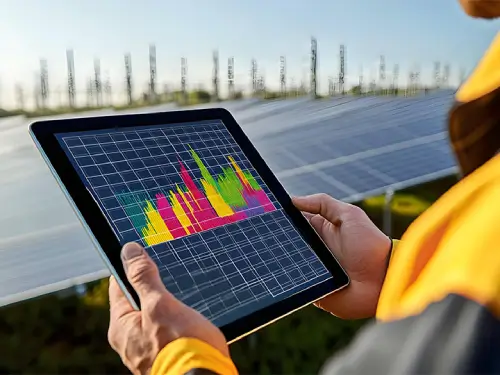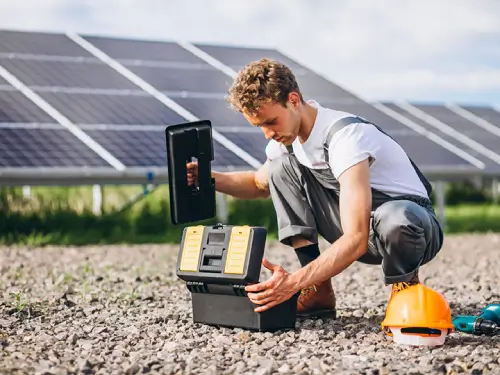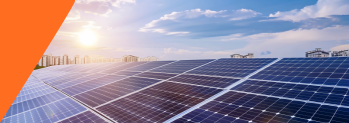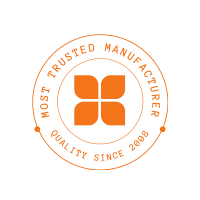In large-scale solar projects, maximizing energy output from every square meter of land is crucial. Unlike traditional static solar panels that remain fixed in one direction, Solar tracker systems enable panels to follow the sun’s path throughout the day. By continuously tilting and adjusting the angle of the panels, trackers ensure that sunlight is captured more efficiently, increasing overall energy generation. This technology is especially useful in utility-scale solar farms, where optimizing space and boosting output can significantly improve the project’s performance and return on investment.
What Is a Solar Tracker?
Solar trackers are a mechanism used in solar PV systems to adjust the angle of the solar photovoltaic (PV) modules as the sun moves across the sky. This allows the panels to be positioned to directly face the sun’s position, thereby increasing the amount of solar energy harvested and improving the energy yield of the system.
How Do Solar Tracking Systems Work?
Solar tracking systems are mechanical setups that move solar panels to follow the sun’s path from east to west throughout the day. This real-time movement is powered by motorized equipment, often integrated with automated systems and sensors that detect the sun’s position and guide the panels to maintain the optimal angle for energy generation.
Key Components of a Solar Tracking System
Types of Solar Trackers
Solar trackers are a good tool for increasing power generation, and are best suited for larger installations where maximizing efficiency and maximizing return on investment is important. Solar tracker systems come in different designs, each with its own advantages and disadvantages. Tailored to optimize sunlight capture and boost energy generation based on site requirements and scale of installation.
1. Single Axis Solar Tracker:
This tracker moves the solar panels in a single direction – typically east to west – throughout the day in approximate sun movement. The tracker will change the angle of the solar panels as the sun moves throughout the sky, which helps gather more solar energy during daylight hours. Simply moving can increase solar energy production by 25–35 % from stationary systems.
Advantages:
Disadvantages:
2. Dual Axis Solar Tracker:
This tracker allows the panels to move in two ways, east to west and north to south. Because of the dual axis, the tracker can accurately follow the sun across the sky daily and throughout the entire year. The tracker can change position regarding the sun every day of the year to maximize energy generation in any climate, resulting in much greater efficiency while increasing energy production by up to 40%.
Advantages:
Disadvantages:
Why Choose Solar Trackers Over Fixed-Tilt Systems?
Solar trackers significantly increase energy production, enhance system performance, and improve return on investment, especially in large-scale projects or regions with high solar exposure. While fixed systems are simpler and cheaper upfront, trackers offer much greater long-term value by making the most of every ray of sunlight.
Where Are Solar Trackers Most Effective?
Depending on the design and rotation axis of the solar tracker, different types of solar trackers are suited for various applications across utility-scale, industrial, agricultural, and hybrid energy setups.
1. Utility-Scale Ground-Mounted Solar Farms:
Utility-scale solar farms benefit the most from tracker installations due to their large open spaces and high energy generation needs.
Ideal tracker types: Horizontal Single-Axis Trackers (HSAT), Horizontal Tilted Trackers (HTSAT), and Dual-Axis Trackers
2. Industrial Rooftops:
Industrial rooftops have limited space and unique structural constraints.
Ideal tracker types: Tilted Single-Axis Trackers (TSAT), Dual-Axis Trackers (TTDAT)
3. Agriculture-Based Solar Fields (Agri-Photovoltaics):
In agricultural fields where crops and solar panels must coexist, choosing the right tracker is crucial.
Ideal tracker types: Vertical Single-Axis Trackers (VSAT), HTSAT
4. Hybrid Energy Systems (Solar + Storage or Solar + Wind):
Hybrid systems aim to maximize energy from multiple sources.
Ideal tracker types: Dual-Axis Trackers (AADAT, TTDAT), TSAT


Conclusion
Solar trackers help solar panels produce more electricity by following the sun throughout the day. They make better use of space and improve energy output, especially in large solar farms. With added features like wind sensors and safety systems, they also protect the panels. If you’re planning a new solar project or want better results from an existing one, solar trackers are a smart way to boost performance and get more from your investment.




